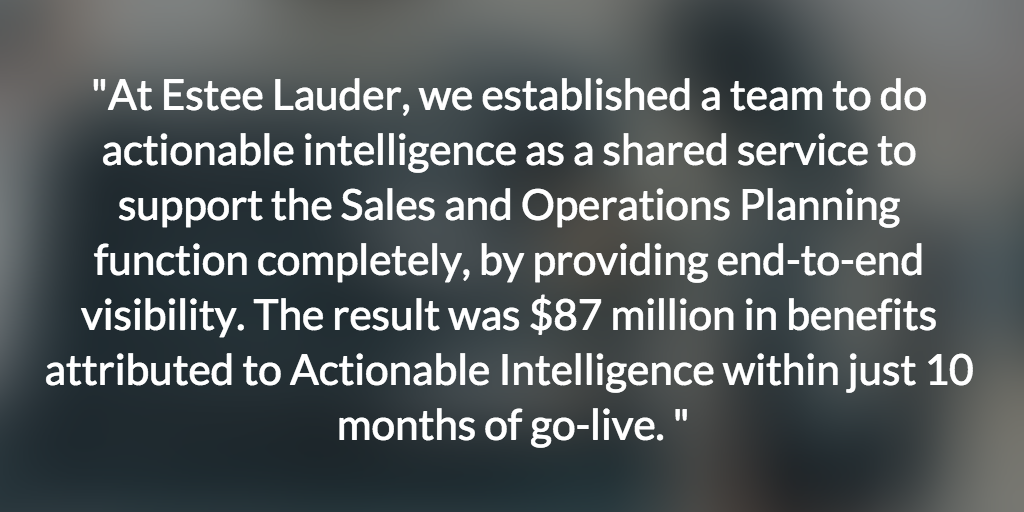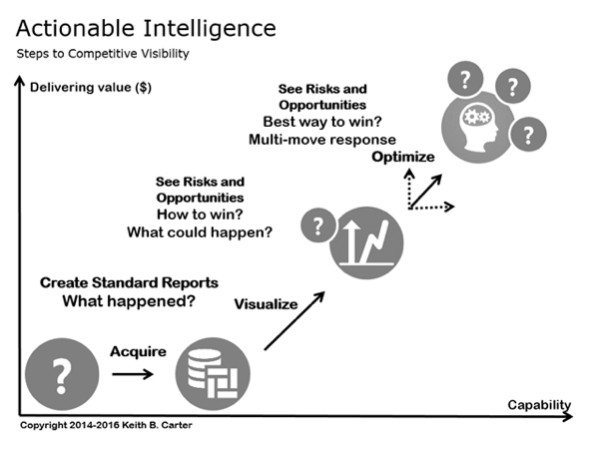Keith B. Carter on The Path to Actionable Intelligence
 Big data, analytics, BI…Everyone in business today has heard these terms at some point, and yet the path to analytics-driven business improvement remains somewhat elusive. We spoke with Keith B. Carter, Actionable Intelligence Expert and Decision Sciences Visiting Senior Fellow at the National University of Singapore Business School and Affiliate Professor Business Analytics Center, to unravel some of the difficulties managers face while embracing an analytics culture and discuss some best practices for success.
Big data, analytics, BI…Everyone in business today has heard these terms at some point, and yet the path to analytics-driven business improvement remains somewhat elusive. We spoke with Keith B. Carter, Actionable Intelligence Expert and Decision Sciences Visiting Senior Fellow at the National University of Singapore Business School and Affiliate Professor Business Analytics Center, to unravel some of the difficulties managers face while embracing an analytics culture and discuss some best practices for success.
Keith is a global supply chain operations leader with over 16 years of extensive global experience in the Cosmetics-Beauty, Government, and Financial Services industries. He has managed teams across continents – from the United States to Belgium and Singapore. Previously, he worked at Estée Lauder in a variety of global supply chain roles, and Accenture in financial services and government. His book. Actionable Intelligence: A Guide to Delivering Business Results with Big Data Fast!, provides expert guidance to establish a culture of fact-based decision making and appropriate high-speed governance.
Keith, as someone who has worked with companies in multiple regions (Europe, North America, Asia), how do you see the adoption of analytics evolving? Are some regions more advanced in their level of adoption?
The U.S. has been a very fast technology adopter for the past 15 years, and continues to be a leader in analytics adoption. Europe is very close behind. In Asia, however, you have 2 different kinds of companies. You have amazingly innovative firms like Alibaba, which tend to be great tech adopters, but then there are large conglomerates or 2nd generation businesses that are lagging behind.
Some people will tell you that this is due to the culture in Asian countries, but the main reason is actually how senior management views analytics technology and exposure they’ve had to technology. In America, for instance, anyone who went to engineering school in the 80s and 90s was doing modeling on a computer. As a result, people who are currently in managerial positions are comfortable with modeling tools like AIMMS. You had great exposure in academic settings. That wasn’t the case in Asia back then. The academic landscape was very different. Now, the access to statistical and modeling software is built into the curriculum here in Singapore and elsewhere in Asia. But this generation of leaders won’t be in decision-making positions for another 10-20 years. So adoption in Asia is moving at a slower pace.
Where should business leaders start if they want to embrace big data analytics?
There is a huge marketing push for big data at the moment. You will find literature at a basic level (in technology blogs) and some more nuanced resources published by companies like McKinsey, Gartner, etc. If you’re looking for a book that talks business, methodology and capability, then Actionable Intelligence is a good place to start. I wrote the book to create conversation and share my experience on where to start and how to embrace the Actionable Intelligence way of running a business.
As I discuss in the book, it’s important for business leaders to understand that big data means nothing unless you can process it fast enough and bring the right information to the right person at the right time to make better decision and improve outcomes. When you process data, you should start with visualization first. Visualization gives you an overview of the data you have available and sheds light on the types of relationships between data. It also helps you identify bad data. As soon as you’ve completed this initial step, you can start trusting your data. Then, you can apply a tool like AIMMS to enhance decision-making, refine your business and use cash and resources in an optimal way.
Speaking of tools, how do you chose the right tool for your business?
Anyone who is evaluating tools needs to look for three things: speed, ease of use and ensuring data accuracy.
Everyone likes Facebook and Twitter, why? Because you get (graphical) information fast in a friendly user interface. The bar is set even higher for intelligence tools. Taking the time to review intelligence is an option, if it takes too long to gather the data or it’s too hard to consume, then there’s a strong temptation to “go with the gut”, so tools need to be fast, reliable and effective. The tool should also help you validate your data. That is why Excel is still the most widely used tool to try to do business intelligence with. It’s easy to use and makes it easy to fix problematic data – despite being completely inadequate for optimization.
Embracing analytics is as much about tools as it is about your organizational culture. How do you encourage your team to become more data-driven?
You need to change your business culture and your IT culture.
- On the business side, business leaders must adopt the change, they need to start asking for the facts. “Don’t just tell me, SHOW me the situation” is the phrase that should be heard in meetings, offices, and hallways. Another part of changing your business culture is using “data as a tool for collaboration instead of as a weapon.” Too often, different teams come into a meeting ready to defend their positions instead of working collaboratively. As a leader, you need to change the mindset from “whose fault is this” to “how can we fix this together.”
- On the IT side, you need to have 2 disciplines: high speed, and a way to capture the benefits that intelligence provides. Too often, the story often goes something like “I went to IT to ask for a report and I had to sign a form, request a meeting and 6 months later I got something that wasn’t useful.” This needs to change. Intelligence needs to be delivered fast. You need to inject speed into your innovation process. You shouldn’t be caught up in red tape. Intelligence projects should follow a post-governance methodology which funds projects immediately and then reviews the results to calculate the return on investment.
How do you manage the balance between gut feel and what the data tells you?
Let’s look at an example. A major manufacturing company with excellence in supply chain was facing the same challenge. They have various product supply planners across Asia (some of the best in the world). But they were not satisfied with 98% customer service (excellent by most standards), they wanted to achieve 99%. They asked themselves, why do some planners do well even though they don’t follow what the system says? We went through a 6-month project to understand that. What we found: planners had access to a lot of data in the system but still not enough.
In December, for example, the Philippines experiences a slow down because of the holidays and last year things slowed down even more because of the pope’s visit. The pope’s visit meant that the port was almost shut down. Good planners knew that, but the system did not know that this would happen. This is where the gap is. The system needs to know as much as the human does in order to bridge the intuition gap. The smarter system, the better the plan.
What would you say are some best practices for defining your company’s analytics strategy?
The first thing you need to realize is that embracing analytics is not a systems project, it’s a business project that requires a culture change. Business leaders should give analytics strategy the focus that it deserves by establishing a separate strategy for actionable intelligence. Set up a separate organization that acts as a shared service to provide info across the business. For this to succeed, there needs to be a c-level business sponsor. I discuss several success stories in my book.
 At Estée Lauder, for instance, we established a team to do actionable intelligence as a shared service to support the Sales and Operations Planning function completely, by providing end-to-end visibility. With a senior sponsor we created a corporate actionable intelligence strategy, linked it with measuring corporate objective achievement and set up the post-governance methodology to achieve a high rate of speed. This matched with a change in overall corporate success objective and incentivize action towards that goal. Adjusting the incentive programs to focus multiple business units on achieving a corporate goal helps the entire company collaborate, share and deliver optimal results. In addition, our Intelligence projects followed a post-governance methodology meaning a budget for intelligence is provided as a bucket, then as requests are made they are funded immediately from the bucket with only a senior leader managing the spending. At quarter or year end, a review is performed to identify the savings, and if the results are positive the funding is renewed. This forces the IT intelligence project to be measured for usefulness – often a forgotten step as people focus on gaining the funding at first. The result was $87 million in benefits attributed to Actionable Intelligence within just 10 months of go-live. So I often ask business leaders, “How much have you gained in benefits from business intelligence?” If it’s not being measured, start, and start now… I’d be glad to share some best practices in more detail.
At Estée Lauder, for instance, we established a team to do actionable intelligence as a shared service to support the Sales and Operations Planning function completely, by providing end-to-end visibility. With a senior sponsor we created a corporate actionable intelligence strategy, linked it with measuring corporate objective achievement and set up the post-governance methodology to achieve a high rate of speed. This matched with a change in overall corporate success objective and incentivize action towards that goal. Adjusting the incentive programs to focus multiple business units on achieving a corporate goal helps the entire company collaborate, share and deliver optimal results. In addition, our Intelligence projects followed a post-governance methodology meaning a budget for intelligence is provided as a bucket, then as requests are made they are funded immediately from the bucket with only a senior leader managing the spending. At quarter or year end, a review is performed to identify the savings, and if the results are positive the funding is renewed. This forces the IT intelligence project to be measured for usefulness – often a forgotten step as people focus on gaining the funding at first. The result was $87 million in benefits attributed to Actionable Intelligence within just 10 months of go-live. So I often ask business leaders, “How much have you gained in benefits from business intelligence?” If it’s not being measured, start, and start now… I’d be glad to share some best practices in more detail.
Visit www.keithbcarter.com to learn more about Keith’s work or connect with him on LinkedIn.






